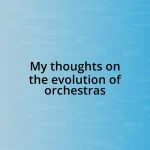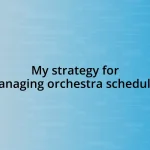Key takeaways:
- Effective communication in music relies on gestures, eye contact, and active listening to create deeper connections among musicians.
- Building rapport through informal interactions and shared experiences cultivates trust and individuality within an orchestra.
- Emotional engagement and collaborative exploration during rehearsals enhance the interpretation and performance of music.
- Effective leadership combines preparation for challenges, open communication, and a balance of authority and approachability to inspire musicians.

Building effective communication in music
Building effective communication in music is essential for any conductor. I remember the first time I conducted an ensemble; there was a palpable tension in the air. I learned that clear gestures and eye contact could bridge gaps that words often couldn’t. Isn’t it fascinating how a simple nod or a lift of the hand can translate into a world of understanding among musicians?
When I was rehearsing a complex piece, I noticed that offering brief, encouraging feedback made a significant difference in my musicians’ confidence. It’s not just about the music; it’s about fostering a supportive environment where everyone feels heard and valued. Have you ever been in a situation where the right words—or even silence—created a deeper connection? It truly transforms the dynamics of the group.
I often reflect on the importance of active listening in my role. It’s not merely about directing; it’s about truly hearing the nuances of each instrument and the emotions they convey. In my experience, when musicians sense that their voices matter, the music they create becomes richer and more profound. How do you convey your thoughts when the music starts speaking for itself? It’s a delicate balance, but one that can elevate the entire performance.

Developing a strong orchestra rapport
Developing a strong rapport with your orchestra is something I’ve come to appreciate deeply over the years. I recall one memorable rehearsal where I took a few moments to join the musicians in casual conversation before we began. The atmosphere shifted dramatically; what started as a gathering of individual performers transformed into a connected team ready to share a musical journey. Engaging in these small, personal moments can be surprisingly powerful in forging relationships that transcend the podium.
Another aspect that has been enlightening is how shared experiences can foster trust within the orchestra. During one winter concert season, we faced numerous challenges, from unpredictable weather to last-minute changes in program. I chose to openly acknowledge these hurdles and share my own feelings of uncertainty. By being transparent, I found that the musicians opened up, leading to a collective resilience. Isn’t it reassuring to know that vulnerability can be a strength in building connections?
Ultimately, it’s about creating an environment where individuality is celebrated. I’ve seen how recognizing each musician’s unique contributions not only boosts morale but also enhances the overall sound. There was a time when I highlighted specific solos and thanked the soloists publicly during rehearsals. This simple acknowledgment cultivated an atmosphere of mutual respect. What are some ways you acknowledge the contributions of those around you? This practice goes a long way in deepening the relationship between conductor and orchestra.
| Approach | Description |
|---|---|
| Informal Interactions | Engaging in casual conversations fosters a sense of camaraderie. |
| Shared Experiences | Being transparent about challenges strengthens trust among musicians. |
| Individual Recognition | Acknowledging unique contributions enhances morale and encourages collaboration. |

Interpreting music for live performance
Interpreting music for live performance is an exhilarating journey of discovery. I remember leading a performance of Mahler’s symphony, a piece brimming with emotional depth. Each note carried a story, and I found myself often asking the musicians to tap into their own emotions to bring those stories to life. When we connected our interpretations, the music transcended the page and became something uniquely ours—charged with energy and feeling.
To ensure a compelling interpretation, I focus on several key aspects:
- Flexible Interpretation: Adjusting tempos and dynamics based on the mood of the performance can create a transformative experience.
- Collaborative Exploration: Encouraging musicians to share their interpretation fosters creativity and a sense of ownership in the music.
- Emotional Engagement: Inviting musicians to recall personal memories tied to the music enhances the emotional depth they can convey.
By taking these small yet impactful steps, we create a performance that resonates not just with the audience but with ourselves as performers.

Navigating challenges in conducting
Navigating the challenges of conducting can be quite daunting, but I’ve learned that preparation is key. I remember one concert where we faced severe last-minute changes due to a sudden illness in the orchestra. Instead of panicking, I gathered my thoughts and outlined a new game plan, reassuring the musicians that we could still deliver a great performance. Isn’t it fascinating how challenges often become opportunities for growth when approached with the right mindset?
Communication is another crucial aspect of overcoming hurdles in conducting. During a particularly challenging rehearsal, I noticed that a few musicians were getting frustrated with my cues. Instead of dismissing their concerns, I took a moment to listen to their feedback. This led to a candid discussion about our dynamics and ultimately enhanced the overall coherence of our performance. Have you ever found that an open line of communication can completely transform a tense situation?
I also believe that balancing authority and approachability is essential. I once led a rehearsal where I realized my strict demeanor was stifling the creative spirit of the orchestra. By loosening up a bit, sharing a laugh, and encouraging input, I noticed an immediate change in energy. That day, I understood the power of being both a leader and a teammate. How do you navigate the duality of authority and collaboration in your own experiences?

Inspiring musicians through leadership
In my experience, inspiring musicians is often about creating a shared vision that resonates with everyone involved. I recall a time when I worked with a young ensemble preparing for a local festival. We sat together before our first rehearsal, discussing not just our goals, but what each musician hoped to express through the music. This open dialogue energized the group, making each individual feel valued and part of a greater narrative. Have you ever noticed how much more a team can achieve when everyone is emotionally invested in the common goal?
I find that leadership is as much about listening as it is about directing. There was a rehearsal where an exceptionally talented violinist timidly approached me with an idea for an alternate interpretation of a passage. Instead of brushing it aside, I invited her to demonstrate it to the group. Watching her confidence blossom as her peers embraced her idea was deeply moving. Isn’t it remarkable how empowering others can lead to unexpected brilliance within the ensemble?
Establishing a supportive atmosphere can unleash the creativity embedded in every musician. During one performance of Beethoven’s Fifth Symphony, I made it a point to highlight moments of collaboration between sections. By calling attention to the connection between the strings and woodwinds, I could see musicians light up with pride and inspiration. It’s a reminder that great leadership isn’t just about guiding; sometimes, it also means stepping back and illuminating the beautiful threads that weave us together. How do you foster such connections among your team?














